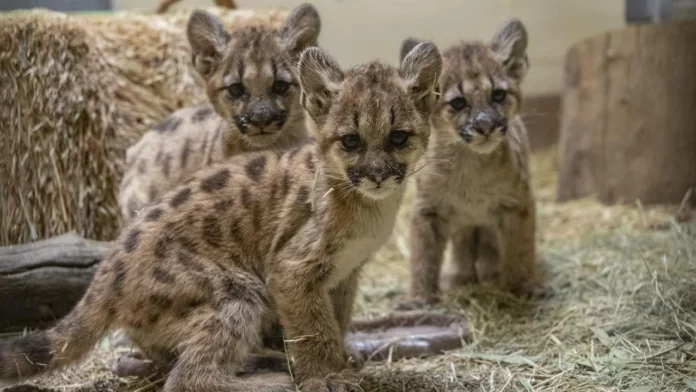The cubs’ rescue is part of a conservation effort to protect the species as they face a rapid population decline
By KATIE HELLMAN — science@theaggie.org
Mountain lions — also called cougars, panthers or pumas — are a keystone species, as other species in the ecosystem largely depend on them. They can be found anywhere from Canada to the tip of South America and live in a wide variety of environments, such as mountains, deserts and coastal areas. They are solitary animals and can be identified by their long hind legs, sleek body and curved claws.
Recently, three mountain lion cubs were rescued by the UC Davis Karen C. Drayer Wildlife Health Center along with the San Diego Zoo Wildlife Alliance and the California Department of Fish and Wildlife.
Over the period of a week, each six-week-old cub was found in their own location but still within 250 feet of the other cubs. The rescuers used the GPS collar of the cubs’ mother to establish the parameters of their search. The first two cubs were found on the same day — one was hiding in a hole and the other was between two rocks — and the third cub was found three days later. Throughout the remainder of the week, trail cameras searched for signs of more cubs, but didn’t find any.
Winston Vickers, director of the Mountain Lion Project at the Karen C. Drayer Wildlife Health Center, commented on the process leading up to the cubs’ rescue.
“Their mother was collared in San Diego County and we had been following her,” Vickers said. “We had noted that when we collared her, she had a kitten and that kitten had appeared to mature and disperse, and then we noticed that her data indicated she was probably denning again. For about six weeks she had been denning and then we learned that she had been killed.”
Once the cubs were safely located, they were assessed and treated for dehydration and then transported to the veterinarian. If they had not been found, they may not have survived even a week on their own. The mountain lions will live at the San Diego Zoo Safari Park and receive lifelong care; since they were separated from their mother at a young age, they will no longer be able to gain the survival skills they need to live in the wild.
Mountain lions used to live throughout the country, but human activities have been causing their rapid population decline, according to the Mountain Lion Foundation.
“Mountain lions used to be found throughout the United States, but due to bounty hunts in the early 1900s and threats such as persecution, trophy hunting, poaching, retaliation in response to livestock depredation, kitten orphaning, poisoning and habitat loss and fragmentation, mountain lions are now only found in 15 western states,” their website reads.
Vickers mentioned that in young mountain lion populations specifically, predators are one of the main causes of death.
“[The cubs] can get taken by predators like coyotes and bobcats,” Vickers said. “The mothers have to be away from them for fairly long periods of time — sometimes over a day — hunting, and so they’re susceptible even though the mothers hide them really well.”
Many conservation efforts have been put into effect to try and increase their populations, such as the aforementioned rescue mission. Organizations dedicated to increasing ecological biodiversity have been making an impact as well. For example, the Center for Biological Diversity has been working to secure state-level protection for mountain lions in California, and one of the ways they have done this is by petitioning to list certain mountain lion populations as “evolutionarily significant” under the California Endangered Species Act.
“That would prevent state and local authorities from approving highway or development projects that jeopardize the persistence of these populations by not accounting for adequate connectivity,” the article reads. “And state agencies would have a clear legal mandate to protect mountain lions and improve connectivity, such as by proactively building wildlife crossings at existing barriers and upgrading culverts.”
It’s crucial for humans to continue to increase their conservation efforts before mountain lions become threatened to the point of extinction.
“[Mountain lions] are iconic and they’re charismatic megafauna, but most people don’t really think about them, and most people in California assume that they’re doing fine because they’re not hunted here,” Vickers said. “That’s been the shocking thing about our findings and something we want to continually put out there — they’re not fine.”
Written by: Katie Hellman — science@theaggie.org




